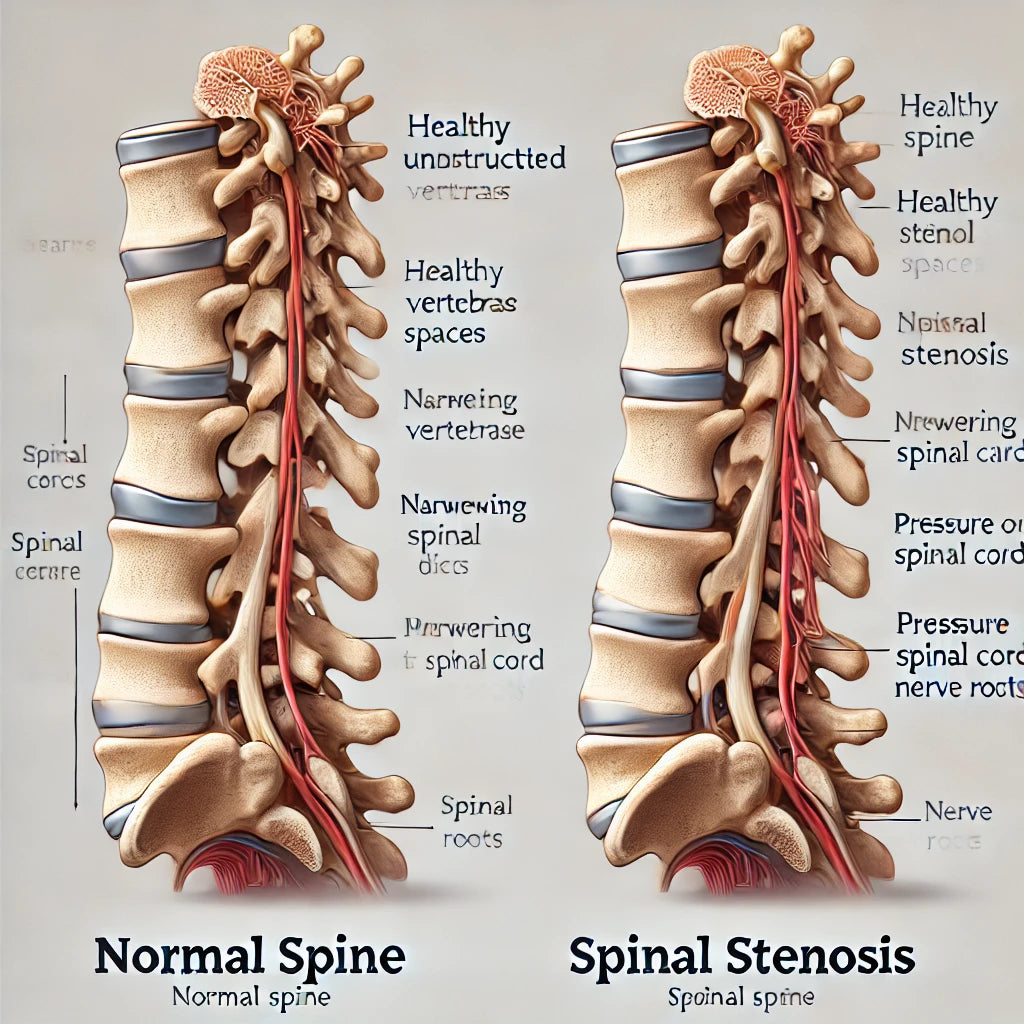
Spinal Stenosis
Share
Spinal Stenosis is a medical condition characterized by the narrowing of spaces within the spine, which can put pressure on the spinal cord and nerves. This compression can cause pain, numbness, muscle weakness, and, in severe cases, impair function in the legs and arms.

Condition and Anatomy
Spinal stenosis often affects the lumbar (lower back) and cervical (neck) regions. The narrowing can occur within the spinal canal (central stenosis), in the space where the nerves exit the spine (foraminal stenosis), or around the nerve roots (lateral stenosis). These spaces can narrow due to various structural changes in the spine that naturally occur with aging or due to underlying conditions.
Causes
The primary causes of spinal stenosis include:
- Degenerative changes: As people age, the discs between their vertebrae naturally lose water content and elasticity which leads to natural wear and tear on the spine, causing conditions such as osteoarthritis, which can result in thickened ligaments, bone spurs, and disc degeneration. This disc degeneration leads to a reduced disc height, which can cause vertebrae to move closer together and compress nerves.
- Herniated discs: Herniated discs are a common cause of spinal stenosis in both the cervical (neck) and lumbar (lower back) regions of the spine, where nerve compression can lead to significant pain and mobility challenges. Herniated discs also often release inflammatory substances that can further irritate nerves in the spinal canal. This inflammatory response contributes to the pain and can exacerbate the narrowing effect of the herniated disc.
- Congenital conditions: congenital conditions can cause spinal stenosis. Congenital spinal stenosis refers to a condition where an individual is born with a narrower spinal canal due to abnormalities in the spine's development. Unlike acquired spinal stenosis, which develops over time due to aging or injury, congenital stenosis is present at birth and often diagnosed in young adults.
- Trauma: Accidents or injuries can lead to fractures, dislocations, or swelling that restrict space in the spine.
- Tumors: Although rare, tumors on the spine can cause compression on the spinal cord and nerves.

Early Symptoms
The early symptoms of spinal stenosis depend on the location and severity of the narrowing:
Lower Back (Lumbar Stenosis):
- Pain or cramping in the legs, particularly when standing or walking.
- Relief when sitting or bending forward.
- Weakness or numbness in the legs.
- Difficulty with balance and coordination.
- Pain, stiffness, or numbness in the neck, shoulders, and arms.
- Weakness in the arms or hands.
- In severe cases, bowel or bladder dysfunction due to spinal cord compression.
- Radiating pain, tingling, or numbness along affected nerves.
- Muscle weakness in areas served by compressed nerves.
- Difficulty walking or maintaining balance, especially in more advanced stages.
Conclusion
Spinal stenosis is a complex condition characterized by the narrowing of critical spinal spaces, leading to significant discomfort and mobility challenges. Whether caused by degenerative changes, herniated discs, congenital factors, trauma, or tumors, the resulting compression on nerves and the spinal cord can profoundly impact a person's quality of life. Symptoms such as pain, numbness, and weakness in the lower back, legs, neck, or arms can escalate if left untreated.
Early diagnosis is essential in managing spinal stenosis effectively. Recognizing the signs, such as pain relief when bending forward or sitting, weakness in the extremities, or radiating pain, allows for timely intervention. Treatment options range from conservative measures like physical therapy and medication to surgical interventions in severe cases.
Awareness of spinal stenosis, its causes, and its symptoms empowers individuals to seek appropriate care and adopt lifestyle modifications to manage symptoms and preserve mobility. Consulting with healthcare professionals ensures personalized treatment plans tailored to the severity of the condition, promoting long-term well-being and improved quality of life.
